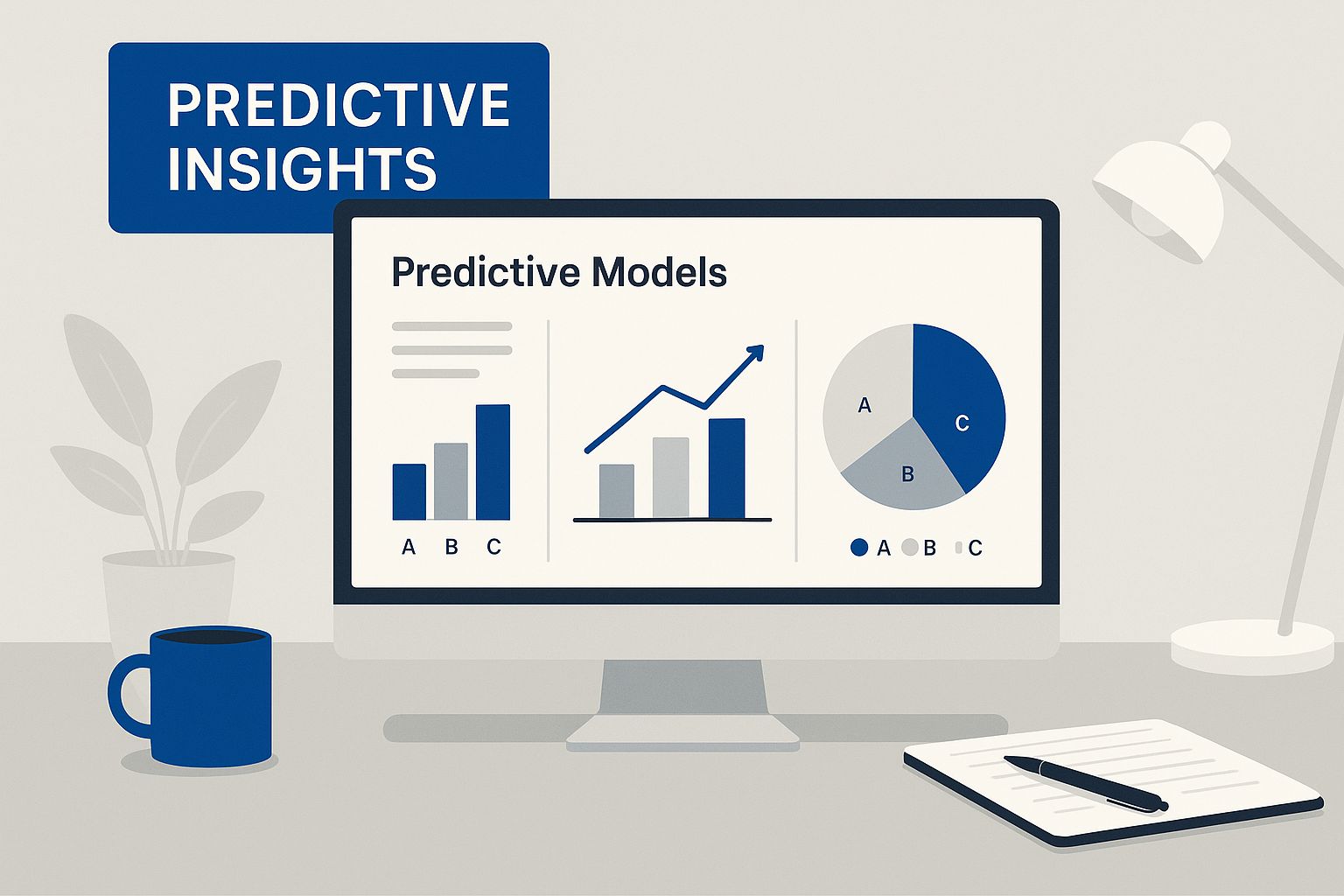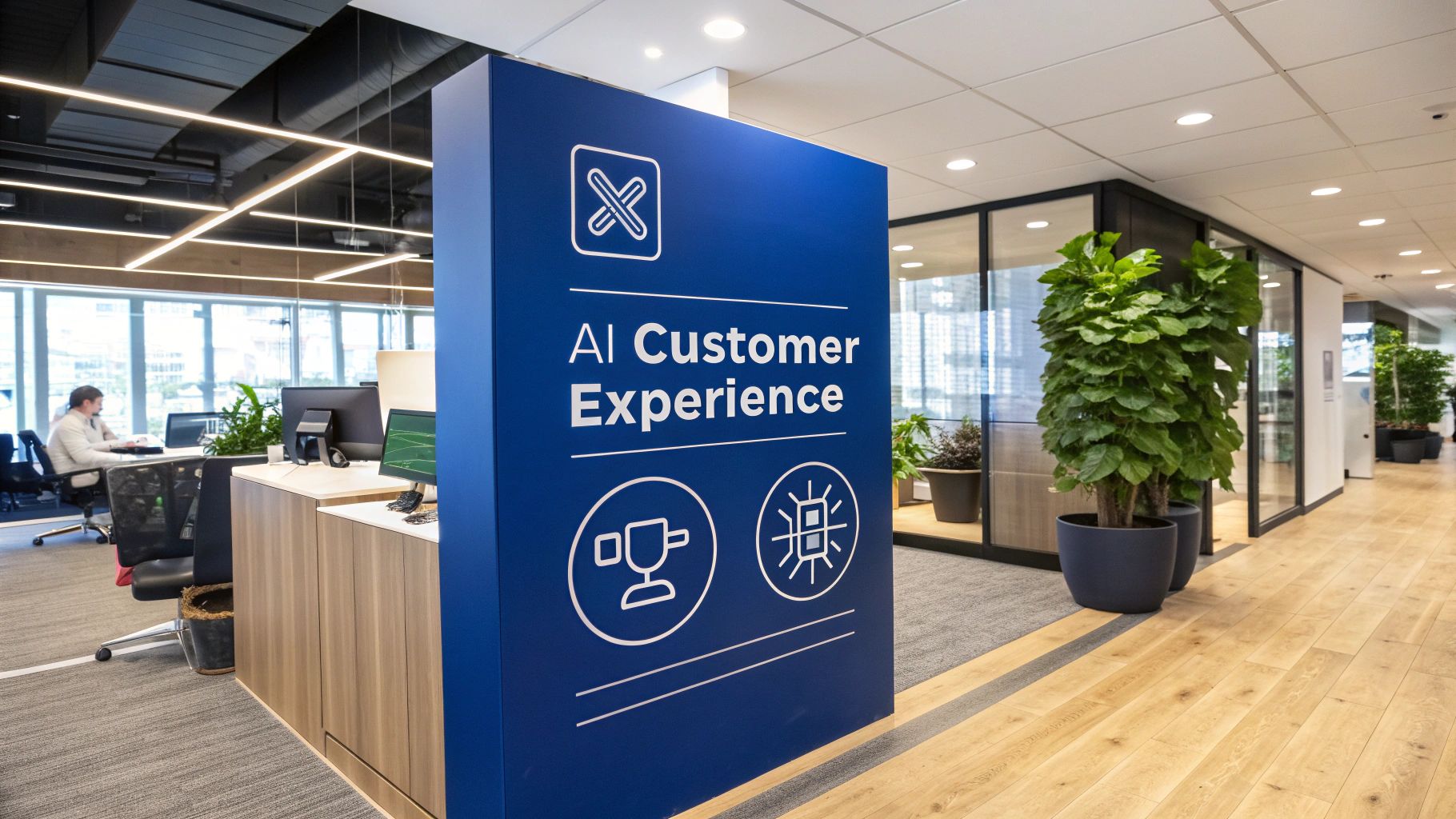When we talk about an AI-driven customer experience in insurance, what we’re really talking about is using smart technology to make every interaction quicker, more intelligent, and deeply personal. It's about swapping out old, clunky processes for smooth digital experiences. This means everything from getting a quote instantly to filing a claim with a few taps on your phone.
Ultimately, this technology is helping insurance evolve from a passive safety net into an active partner in your life.
The New Era of Insurance Customer Service

For a long time, the insurance industry seemed to be stuck in another era. It was all about piles of paperwork, policies filled with confusing jargon, and claims processes that moved at a snail's pace. Getting in touch with your provider often involves long waits on hold and repeating your story to multiple people. The relationship felt distant and purely transactional, with little effort to adapt to your changing life.
That old model is finally being dismantled. The arrival of artificial intelligence isn't just a small tweak; it’s completely changing how insurance companies work and, more importantly, how they connect with customers. It's like the jump from a paper map to a live GPS that updates your route based on traffic. AI offers that same kind of smart, predictive guidance for your insurance coverage.
Redefining the Customer Relationship
An AI-powered customer experience is built around the idea of a partnership, not just a policy. It uses data and machine learning to understand what you need before you even ask, making interactions simple and offering real value that goes beyond just processing a claim.
This new approach stands on a few core ideas:
-
Proactive Engagement: Imagine getting an alert about a hailstorm heading your way with tips on how to protect your car before the damage happens. That's AI at work.
-
Hyper-Personalization: Instead of lumping you into a broad category, your premiums can be based on your actual driving habits, rewarding you for being safe on the road.
-
Instant Gratification: AI chatbots are available 24/7 to answer your questions or handle simple requests immediately, without you having to wait for business hours.
-
Seamless Simplicity: Tasks like underwriting or submitting a minor claim are automated, turning what used to be a drawn-out process into a quick, straightforward digital experience.
At its heart, AI for Customer Engagement is about making every touchpoint more meaningful and efficient. This shift is critical, with some studies suggesting that 95% of customer interactions will be managed by AI by 2025. It’s not about getting rid of people, but about elevating their roles. This frees up human agents to focus on the complex, sensitive situations where empathy and expertise really matter.
By handling the routine work and pulling meaningful insights from data, AI gives insurers the tools to build stronger relationships based on trust. It turns the customer journey from a series of stressful, disconnected events into a continuous, supportive conversation. This is the new standard customers are already starting to expect.
How AI is Rewriting the Insurance Rulebook
To really get a feel for how an AI-driven customer experience is shaking up the insurance world, we need to pop the hood and look at the core technologies making it all happen. These aren't just buzzwords; they're the engines behind every personalized quote, instant claim, and helpful alert. Once you understand these pieces, you can see how they fit together to create a smarter, more responsive insurance journey for everyone.
Think of it like a team of specialists. Each one has a unique skill, but they all work together to build something seamless. A car needs an engine, a transmission, and a steering wheel to get you where you're going. In the same way, modern insurance relies on a few key AI pillars to function effectively.
Machine Learning: The Predictive Brain
At the very centre of this shift is Machine Learning (ML). Picture a detective who gets better and better at solving crimes with every new clue they find. That’s pretty much what ML does. It’s a system that sifts through massive amounts of data and learns from it, without needing a human to program every possible outcome.
In insurance, ML algorithms chew through historical claims data, customer behaviour, and market trends to spot patterns. This allows insurers to predict what might happen next with surprising accuracy. For example, an ML model can look at thousands of data points to figure out how likely a person is to make a claim, which leads to fairer and more precise pricing for their premium.
This predictive muscle is fundamental to how AI in insurance is transforming the industry, pushing the whole sector from a reactive stance to a much more proactive one.
Natural Language Processing: The Communication Expert
If machine learning is the brain of the operation, then Natural Language Processing (NLP) is its voice and ears. NLP is the technology that gives computers the knack for understanding, interpreting, and even generating human language. It’s what makes chatbots, voice assistants, and document-reading software actually work.
Think about the claims process. It used to be all about filling out endless forms. Now, a customer could just describe what happened to a chatbot in their own words. The NLP tech underneath would grasp the context, pull out the important details, like the date, location, and type of damage, and get the claim started on the spot.
By bridging the gap between how we talk and how computers think, NLP makes every interaction feel more natural and less like a chore. This tech is a cornerstone for delivering the kind of 24/7, instant support that people have come to expect.
We're already seeing this in action. The way AI chatbots are revolutionizing the role of insurance agents is a perfect example of this shift, making processes smoother and improving how insurers connect directly with customers. It's not just about being more efficient; it's about making insurance easier for everyone to access and understand.
Predictive Analytics: The Future Forecaster
Finally, we have Predictive Analytics. This is where the insights from machine learning are used to make educated guesses about the future. You can think of it as a highly sophisticated weather forecast, but for risk. It doesn't just report on what happened in the past; it uses that history to tell you what's likely to happen next.
This has some seriously powerful implications for the customer experience in insurance. For instance, predictive models can:
-
Spot At-Risk Customers: By analyzing behaviour, an insurer can see when a policyholder might be thinking of leaving and can reach out with a better offer before it's too late.
-
Prevent Losses: A system could analyze data from a car's telematics and warn the driver about worn-out brakes before an accident happens. That prevents a claim entirely.
-
Flag Potential Fraud: These algorithms can spot strange patterns in claims submissions that a person would easily miss, flagging them for a closer look and saving the industry billions.
Put them all together, and you have a powerful trio. Machine learning finds the patterns, natural language processing handles the conversation, and predictive analytics prepares for what's ahead. This is the combination that’s rewriting the insurance rulebook, turning it from a one-size-fits-all product into a smart, personalized service that actually adapts to what each customer needs.
From Quote to Claim with AI-Powered Speed
Talk is one thing, but the real test of an AI-driven customer experience in insurance happens when a customer needs a quote or has to file a claim. These moments have always been the slowest, most frustrating parts of dealing with an insurer. Now, artificial intelligence is flipping the script, turning these potential headaches into refreshingly simple and fast interactions.
Customers no longer have to wait days or even weeks. AI works behind the scenes, processing information and making decisions at a once impossible pace, completely reshaping how a policy works from start to finish.
Instant, Intelligent Underwriting
Remember the old way of getting an insurance quote? It was all about long forms and a lot of guesswork. Underwriters used broad, generic data to figure out your risk, which often resulted in a standard price that didn't really match your specific situation.
AI-powered underwriting is a whole different ball game. It can sift through thousands of data points in real time, things like public records or even driving data from your car (with your permission, of course). In minutes, it builds a highly accurate and personal risk profile.
What does this mean for the customer? A fair, customized quote in a fraction of the time. It’s a more transparent system that rewards safer individuals with better prices, kicking off the customer relationship on the right foot.
This infographic shows just how central predictive insights have become to modernizing every part of the insurance process.

As you can see, AI's ability to forecast outcomes based on data empowers insurers to make smarter, quicker decisions that ultimately create a better experience for you.
A Radically Simplified Claims Process
Let's be honest, filing a claim is usually the most stressful thing a policyholder goes through. It's the moment of truth that determines whether a customer sticks around or walks away. AI is making this process surprisingly painless.
Think about a minor car accident. Here’s how it works now:
-
Snap and Upload: You take a few pictures of the damage on your phone and send them through the insurer’s app.
-
AI Analysis: An AI model looks at the photos, identifies the broken parts, figures out how bad the damage is, and checks it against your policy details; all in an instant.
-
Instant Estimate: Within seconds, the system gives you a preliminary repair estimate and a list of approved body shops nearby.
-
Automated Approval: For simple claims, the AI can even approve the payment right away, sending it to the repair shop or directly to you, sometimes in less than an hour.
This whole process cuts out the paperwork and the agonizing wait times, getting customers back on their feet fast. You can dig deeper into the mechanics of this in our guide on AI insurance claims processing as a game-changer.
"By automating routine claims, insurers can process simple property damage claims in minutes, not weeks, dramatically reducing turnaround time and boosting customer satisfaction."
This isn’t just some future concept; it’s happening right now. Research shows that more than 60% of Canadian insurers expect AI to have a major impact on both underwriting and claims in the near future. The biggest roadblock? Over 70% of insurers are still held back by old legacy systems. You can read more about it in the CAFII and Deloitte research on this topic.
AI Impact on Core Insurance Functions
To see the difference clearly, let's compare the old way with the new AI-powered approach across a few key areas.
|
Insurance Process |
Traditional Approach |
AI-Driven Approach |
Direct Customer Benefit |
|---|---|---|---|
|
Underwriting & Quoting |
Manual review of lengthy applications; broad demographic data. |
Real-time analysis of diverse data points; personalized risk assessment. |
Faster, fairer, and more accurate quotes. |
|
Claims Filing |
Extensive paperwork, phone calls, and manual reviews by adjusters. |
Mobile app photo submission; AI-powered image analysis. |
A quick, simple, and stress-free claims process. |
|
Fraud Detection |
Manual audits and rule-based systems can be slow. |
AI algorithms detect suspicious patterns in real time. |
Lower premiums for everyone due to reduced fraud costs. |
|
Customer Service |
Call centres with long wait times and limited hours. |
24/7 AI-powered chatbots for instant answers; seamless handoff to humans. |
Immediate support anytime, anywhere. |
This table really drives home how AI is not just making things more efficient for insurers, but also creating a fundamentally better and more supportive experience for the people they serve.
The benefits are undeniable. For insurers, it means a massive boost in efficiency, with some seeing a 50-65% drop in processing costs. But for customers, the payoff is even more meaningful: faster help, less stress, and the peace of mind that comes from feeling truly looked after when they need it most.
Building Customer Trust in an AI World
Rolling out sophisticated technology is just one piece of the puzzle. The other, arguably more crucial piece, is earning and keeping your customers' trust as the world becomes more automated. An AI-driven customer experience in insurance can deliver incredible speed and personalization, but none of that matters if policyholders are skeptical of the systems making the calls.
The real challenge is about perception. Customers need to feel confident that the AI is on their side, not working against them. They need to know that the algorithms are fair, their data is locked down, and a real person is still there to help when things get complicated.
The Balancing Act of AI Acceptance
When it comes to AI in insurance, people's feelings are a bit of a mixed bag. They're definitely warming up to the idea, especially when the benefits are clear and immediate. For example, using AI to proactively flag risks is something many people are happy to see.
A North American survey, which is very relevant to Canada's insurance landscape, found that 45% of consumers are comfortable with their insurer using AI to monitor for and send alerts about severe weather. But that acceptance has its limits. The same study showed that 42% of people are worried about how the accuracy of these AI predictions might impact their premiums or coverage. You can read more about these findings on consumer comfort with AI.
This data really shines a light on the trade-off. Customers love AI when it acts like a helpful guardian, but they get nervous when it feels like an unseen judge. This is exactly why being transparent and communicating clearly is no longer optional.
Navigating Data Privacy and Algorithmic Fairness
Dig a little deeper, and you'll find two major concerns at the heart of customer hesitation: data privacy and algorithmic fairness. Insurers now have access to an unprecedented amount of personal data, from telematics in our cars to sensors in our smart homes.
Naturally, policyholders are asking some tough but fair questions:
-
How are you using my data? People want to know exactly what information is being collected and why.
-
Is my data safe? With the constant threat of cyberattacks, rock-solid data protection is just table stakes.
-
Are the algorithms biased? There’s a growing awareness that AI models can accidentally inherit and even amplify human biases, which could lead to unfair pricing or claim denials for certain groups of people.
Tackling these issues head-on is the only way to build real trust. Insurers have to be upfront about their data practices and be ready to explain, in plain language, how their AI systems arrive at a decision. If you don't, that trust can evaporate in an instant. For a closer look at this critical topic, check out our guide on AI and data privacy in insurance explained.
"Trust is the currency of the digital age. In insurance, where you're selling a promise, transparency in how you use AI and data isn't just good practice, it's the foundation of your entire customer relationship."
The Authenticity Challenge in a Digital World
Another problem creeping in is the challenge of maintaining authenticity. As AI gets better at mimicking human conversation, it can be tough for customers to tell if they're talking to a person or a bot. This gets even murkier with the rise of AI-generated online reviews, which can easily distort public perception.
For insurers, this means you have to prove your commitment to genuine customer care. Sure, chatbots are great for handling routine questions, but there must always be an easy, obvious way to reach a human for more complex or emotional issues. Authenticity is built when customers feel truly heard and understood, regardless of who or what they're interacting with.
To build and maintain that trust, insurers should be focusing on a few key principles:
-
Be Radically Transparent: Don't be shy about explaining when and why you're using AI. Give simple, clear explanations of how algorithms influence quotes and claims.
-
Prioritise Data Security: Invest in top-tier cybersecurity and be open about the measures you're taking to protect customer information.
-
Ensure Human Oversight: Always keep a human in the loop for critical decisions. AI should be a tool that assists human judgment, not a replacement for it.
-
Communicate Proactively: Use AI to offer valuable, preventative advice that genuinely helps customers. This shows that the technology is being used for their benefit, not just your bottom line.
By making these practices part of your company's DNA, you can move beyond just the technical side of AI and build a foundation of trust that's essential for keeping customers loyal for the long haul.
Overcoming Hurdles in AI Implementation

While the promise of an AI-powered customer experience in insurance is exciting, getting there isn't as simple as flipping a switch. The journey is less of a straight line and more of a strategic climb, filled with challenges that demand a clear-eyed approach. For many insurers, it means fundamentally rethinking systems and practices that have been in place for years.
To truly tap into what AI can do, you have to face these obstacles head-on. From modernizing ancient technology to navigating a complex web of regulations, the implementation is a major undertaking. It requires careful planning, a real commitment to responsible innovation, and an honest look at the work involved.
Wrestling with Legacy Systems
For many established insurers, one of the biggest roadblocks is their existing legacy IT systems. We're talking about those old, often cumbersome, mainframe-based platforms that have been the backbone of the industry for decades. They were workhorses in their day, but they were never built for the massive, real-time data streams that modern AI thrives on.
Trying to bolt a sophisticated AI onto an outdated infrastructure is like trying to run a high-speed train on rickety, wooden tracks. It’s a recipe for inefficiency and failure. This technological debt is a serious hurdle, with research suggesting that over 70% of insurers see their legacy systems as a primary barrier to adopting AI. Modernization isn't just a nice-to-have; it's the bedrock of any serious AI strategy.
A phased rollout is often the most sensible path forward. Instead of a high-risk "big bang" overhaul, insurers can start by upgrading specific, high-impact areas like claims intake or customer communication. This builds momentum and delivers clear wins early on.
This approach minimizes disruption to the business while demonstrating the value of the investment from the get-go.
The Critical Importance of Data
AI is only as good as the data it's fed. For any AI model to produce accurate, fair, and useful results, it needs a steady diet of high-quality, secure, and well-organized data. The problem is, many insurers have their data trapped in separate, disconnected silos, which makes creating the unified view needed for machine learning a massive headache.
But it’s not just about getting access to the data; its quality and governance are absolutely crucial. Using incomplete or biased data will inevitably lead to flawed algorithms that produce unfair outcomes. This doesn't just erode customer trust; it opens the door to serious legal and reputational risks. That's why setting up a solid data governance framework isn't just a good idea; it's non-negotiable.
This framework needs to cover a few key bases:
-
Data Security: Putting top-tier measures in place to protect sensitive customer information from any potential breaches.
-
Data Quality: Making sure all data is clean, accurate, and consistent across every system in the organization.
-
Regulatory Compliance: Following strict data privacy laws, like Canada's PIPEDA, which dictate how personal information can be collected, used, and shared.
Navigating Regulations and Ethics
Insurance is one of the most heavily regulated industries out there, and for good reason. AI adds a new layer of complexity, particularly when algorithms are making decisions that affect people's lives. Regulators are rightfully taking a closer look, demanding that AI models be transparent, explainable, and free from any discriminatory bias.
Insurers have to be ready to answer some tough questions. If an algorithm denies a policy or calculates a high premium, the company needs to be able to explain why. This means embracing "explainable AI" (XAI), a set of tools and practices designed to make algorithmic decisions understandable to humans.
Beyond the rules, the ethical considerations are huge. An AI-driven customer experience must be built with a human-first mindset. The goal should be for automation to enhance, not replace, the empathy and critical thinking that human professionals bring to the table. Finding that sweet spot between technological efficiency and ethical responsibility is the true test of a successful AI implementation.
What's Next for Insurance and AI?
The evolution of AI in insurance is really just getting started. As we look to the future, it's clear the changes on the horizon will be woven much more deeply into our daily lives. Insurance is shifting from a reactive safety net you only think about when something goes wrong to a proactive, ever-present partner. The next wave of innovation isn't just about making old processes faster; it's about inventing entirely new ways to provide protection.
This future really hangs on the idea of hyper-personalization. Picture an insurance policy that's truly alive, adjusting in real time based on what you do and where you are. Your car insurance premium might dip a little after a week of safe, defensive driving. Or your home insurance could offer instant rebates the moment you activate a new security system. This kind of deep customization makes coverage feel less like a rigid contract and more like a fluid service that truly adapts to your life.
The Big Shift to Prevention
Maybe the most profound change we'll see is the move towards preventative insurance. Instead of simply paying out after a disaster strikes, insurers will use AI to help their clients sidestep risks altogether. We're already seeing the early stages of this, but it's poised to become the industry standard.
-
Smart Home Integration: Imagine your insurer's app connecting directly to your smart home devices, alerting you to a small water leak long before it becomes a flooded basement.
-
Health and Wellness: Data from your wearable tech could be shared with your health insurer, who then provides personalized tips to help you stay healthy, potentially lowering your premiums along the way.
-
Proactive Alerts: AI can analyze weather patterns, traffic data, and local conditions to send you timely warnings, like suggesting a different route to avoid an accident-prone intersection during a snowstorm.
This model fundamentally changes the dynamic between the insurer and the policyholder. Preventing loss becomes a shared goal, which builds a much more positive and collaborative relationship.
Managing a New Reality
Of course, this forward momentum brings its own set of challenges, especially when it comes to public perception and trust. The digital world is increasingly saturated with AI-generated content, which can shape opinions in powerful, sometimes misleading, ways. For instance, the Canadian insurance market has seen a massive spike in AI-generated online reviews. Recent data shows that nearly 22% of all insurance reviews in Canada are likely AI-generated, which is a staggering 988% increase since 2018. You can explore more about how AI is shaping online conversations on this topic. This really underscores the need for insurers to double down on authenticity and build trust through transparent, human-centric practices.
The ultimate goal is to create an invisible, seamless experience. A future where insurance is so well-integrated into a customer's life that it just works quietly in the background, only stepping into the spotlight when it can offer genuine value. That's the future AI is building.
Common Questions About AI in Insurance
As AI weaves its way into more corners of our lives, it’s completely normal to have questions about how it fits into something as vital as insurance. Getting clear on these points helps strip away the hype and see how an AI-driven customer experience in insurance really works in practice.
Building trust is everything when adopting new technology. So, let's dive into some of the most common questions people ask.
Will AI Completely Replace Human Insurance Agents?
Not at all. The goal is to empower human agents, not replace them. Think of AI as the ultimate assistant. It's brilliant at handling the repetitive, data-heavy lifting, things like answering basic policy questions around the clock or gathering initial information for a claim.
This frees up human agents to concentrate on what they do best: navigating complex claims, offering nuanced advice on sophisticated policies, and providing a compassionate ear during stressful situations. The future is a partnership, with AI handling the routine tasks so the human expert can focus on the high-stakes moments where empathy and deep knowledge truly matter.
By 2025, it's projected that AI will handle 95% of all customer interactions, but that figure mostly covers simple, automated exchanges. The crucial conversations, the ones that build loyalty, will still need a human touch.
This hybrid model gives customers the best of both worlds: the instant response of technology and the thoughtful guidance of a seasoned professional.
How Does AI Make Insurance Pricing Fairer?
Traditionally, insurance has relied on broad categories like age, postal code, and gender to set prices. AI flips that model on its head by enabling personalized risk assessments based on individual behaviour.
Take usage-based insurance (UBI) for your car, for instance. Instead of just grouping you with every other driver your age, it looks at your actual driving habits, how safely you brake, how often you drive late at night, and your average speed. AI analyzes these specific data points to calculate a premium that accurately reflects your personal risk.
This means safer drivers are no longer overpaying to subsidize higher-risk individuals in the same demographic bucket. It creates a far more equitable system where your premium is tied directly to your actions.
What Is the First Step for an Insurer to Implement AI?
The key is to start small and solve a real problem. Don't try to boil the ocean with a massive, company-wide AI overhaul right out of the gate. A much smarter approach is to identify a single, specific pain point in the customer journey and target it with an AI solution.
Maybe that means launching a chatbot to handle simple, after-hours customer service queries. Or perhaps it's using an AI tool to speed up the document verification stage of a claim.
Before anything else, though, it's critical to get your data in order. AI is only as good as the data it's trained on, so ensuring your data is clean, organised, and accessible is step zero. A focused pilot project allows you to learn the ropes, demonstrate tangible value, and build momentum before you scale up.
At Cleffex Digital Ltd, we specialise in creating innovative software solutions that help businesses, including those in the insurance sector, solve their most pressing challenges. To learn how we can help you build your next digital solution, visit us at https://www.cleffex.com.








